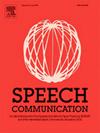An acoustic analysis of the nasal electrolarynx in healthy participants
IF 3
3区 计算机科学
Q2 ACOUSTICS
引用次数: 0
Abstract
The nasal electrolarynx (NEL) is an innovative device that assists patients without vocal folds or under endotracheal intubation in producing speech sounds. The NEL has a different path for acoustic wave transmission to the traditional electrolarynx that starts from the nostril, passes through the nasal cavity, velopharyngeal port, and oral cavity, and exits the lips. There are several advantages to the NEL, including being non-handheld and not requiring a specific “sweet spot.” However, little is known about the acoustic characteristics of the NEL. This study investigated the acoustic characteristics of the NEL compared to normal speech using ten participants involved in two vowel production sessions. Compared to normal speech, NEL speech had low-frequency deficits in the linear predictive coding spectrum, higher first and second formants, decreased amplitude of the first formant, and increased amplitude of the nasal pole. The results identify the general acoustic features of the NEL, which are discussed using a tube model of the vocal tract and perturbation theory. Understanding the acoustic properties of NEL will help refine the acoustic source and speech recognition in future studies.
健康受试者鼻电喉的声学分析
鼻电喉(NEL)是一种创新的设备,可以帮助没有声带或气管插管的患者发出语音。NEL的声波传播路径与传统的电喉不同,即从鼻孔出发,经过鼻腔、腭咽口、口腔,最后离开嘴唇。NEL有几个优点,包括非手持和不需要特定的“最佳点”。然而,人们对NEL的声学特性知之甚少。本研究通过10名参与者参与两个元音生成会话来研究NEL与正常语音的声学特征。与正常语音相比,NEL语音在线性预测编码谱上存在低频缺陷,第一和第二共振峰较高,第一共振峰幅度减小,鼻极幅度增大。结果确定了NEL的一般声学特征,并使用声道管模型和微扰理论进行了讨论。了解NEL的声学特性将有助于在未来的研究中完善声源和语音识别。
本文章由计算机程序翻译,如有差异,请以英文原文为准。
求助全文
约1分钟内获得全文
求助全文
来源期刊

Speech Communication
工程技术-计算机:跨学科应用
CiteScore
6.80
自引率
6.20%
发文量
94
审稿时长
19.2 weeks
期刊介绍:
Speech Communication is an interdisciplinary journal whose primary objective is to fulfil the need for the rapid dissemination and thorough discussion of basic and applied research results.
The journal''s primary objectives are:
• to present a forum for the advancement of human and human-machine speech communication science;
• to stimulate cross-fertilization between different fields of this domain;
• to contribute towards the rapid and wide diffusion of scientifically sound contributions in this domain.
 求助内容:
求助内容: 应助结果提醒方式:
应助结果提醒方式:


